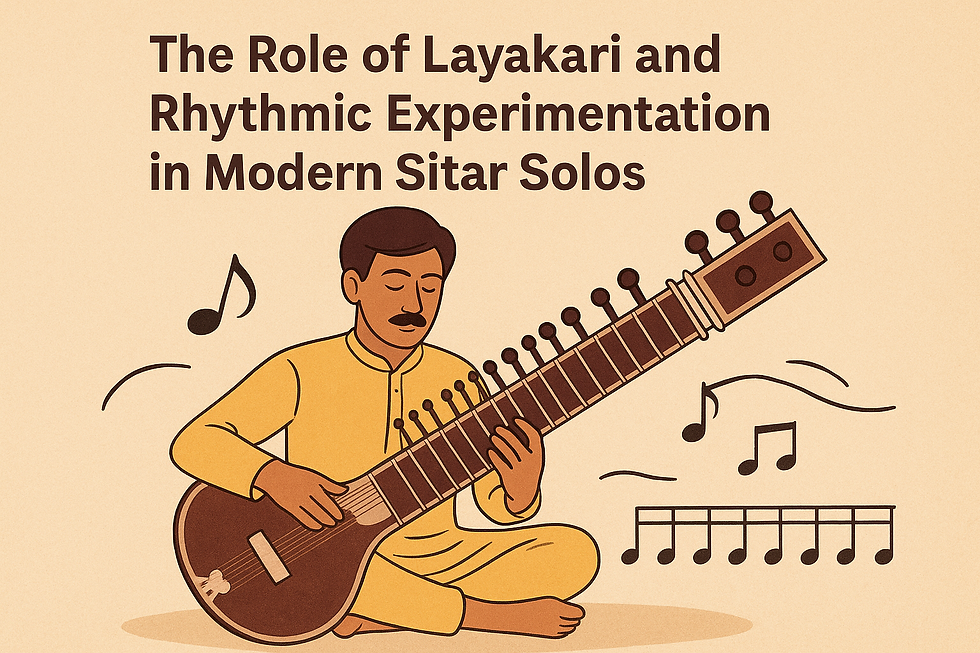"Sitar Strings and Inner Peace: A Guide for Music Learners"
- Sharanya naidu
- Jan 8
- 3 min read
Updated: Jan 17
In the soothing world of meditation music, the sitar reigns as an instrument of profound tranquility and spiritual connection. Renowned for its mesmerizing tonal qualities and intricate resonance, the sitar serves as a bridge between the physical and the metaphysical. For music learners, it provides a gateway to understanding the transformative power of sound for healing, relaxation, and self-discovery.
Why Choose the Sitar for Meditation?

The sitar's ability to produce sustained, melodic tones enriched with harmonics makes it uniquely suited for meditation music. Its sympathetic strings, which vibrate in harmony with the main strings, create layers of depth, resulting in an ethereal soundscape. These natural resonances align with the universe's harmonic frequencies, enhancing their ability to induce calm and mindfulness.
Unlike many instruments, the sitar is inherently designed to evoke introspection and serenity, making it an ideal companion for meditation and therapeutic practices.
Ragas: The Soul of Meditative Sitar Music
Central to sitar music is the concept of ragas, melodic frameworks that evoke specific moods and emotions. Certain ragas are especially effective in promoting relaxation and mindfulness, as they are aligned with particular times of the day or emotional states.
Some meditative ragas include:
Raga Yaman: An evening raga exuding peace and tranquility.
Raga Darbari Kanada: Deep and introspective, ideal for fostering inner calm.
Raga Bageshri: A serene late-evening raga that encourages surrender and mindfulness.
Exploring these ragas helps music learners understand how melodic structures influence emotional and mental states, enabling them to create music that complements meditation practices.
Techniques for Creating Meditative Sitar Music
Crafting meditation music with the sitar goes beyond technical skills. It requires a deep connection between sound and intention. Key techniques include:
Embrace Slow Tempos: Meditation thrives on slow, deliberate tempos. Allow each note to resonate fully, emphasizing clarity and emotion.
Explore Improvisation: The beauty of meditative music lies in its spontaneity. Practice improvising within a raga’s framework, letting the melody flow naturally.
Leverage Sympathetic String Resonance: Harness the sitar’s sympathetic strings to amplify its meditative qualities. Proper tuning enhances their harmonic vibrations.
Incorporate Alap: Begin with an alap (a rhythm-free exploration of the raga) to set a serene and introspective tone.
Healing Properties of Sitar Music
The sitar’s vibrations interact with the body’s energy centers, or chakras, to promote balance and harmony. Playing or listening to the sitar can:
Alleviate stress and anxiety by calming the nervous system.
Enhance concentration and mindfulness, deepening meditation.
Support emotional healing by channeling specific feelings through chosen ragas.
Practical Tips for Beginners
If you’re a music learner eager to explore the sitar’s meditative and healing potential, consider these steps:
Choose a Quality Instrument: Invest in a sitar with excellent tonal quality. Seek guidance from an experienced teacher when selecting your instrument.
Learn from a Guru: An expert teacher can guide you through the nuances of ragas and techniques essential for creating meditative music.
Master the Art of Tuning: The sitar’s resonance depends on precise tuning. Dedicate time to developing this skill.
Practice Consistently: Regular practice builds technique and deepens your connection to the instrument’s emotional depth.
Combine Meditation with Practice: Pair your music sessions with meditation. Observe how different ragas influence your state of mind and overall well-being.
Conclusion
The sitar’s celestial sound holds the power to soothe the mind and uplift the soul. For music learners, it offers more than technical mastery—it’s an invitation to journey inward, discover new dimensions of mindfulness, and share its healing resonance with the world. By blending tradition, creativity, and intention, you can unlock the transformative essence of the sitar and weave its calming melodies into your personal and musical practice.



Comments